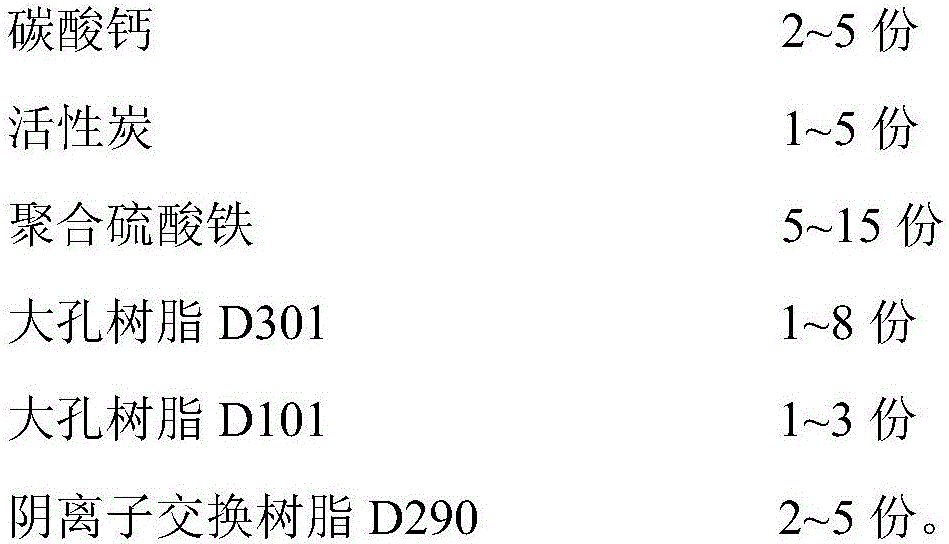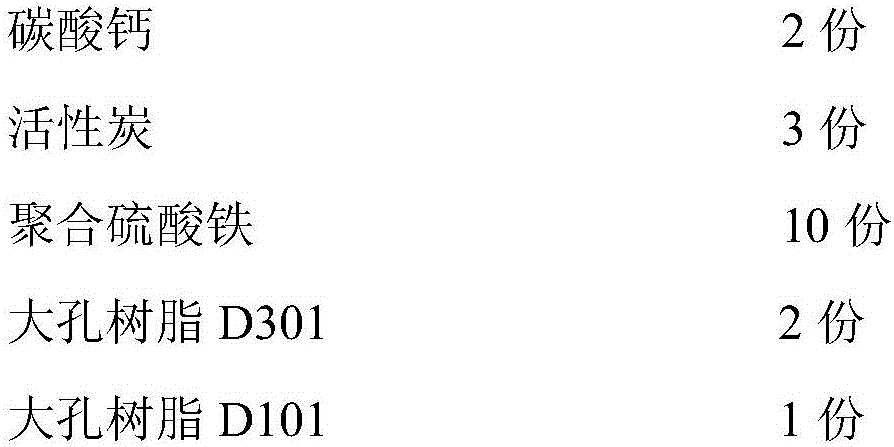Decolorant for textile printing and dyeing wastewater
A technology of textile printing and dyeing and decolorizing agent, which is applied in the direction of textile industry wastewater treatment, water/sewage treatment, water/sludge/sewage treatment, etc. It can solve the problems of low decolorization efficiency, secondary pollution, high production cost, etc., and achieves the preparation method Simple, high decolorization efficiency, low cost effect
- Summary
- Abstract
- Description
- Claims
- Application Information
AI Technical Summary
Problems solved by technology
Method used
Image
Examples
Embodiment 1
[0024] (1) Grind calcium carbonate and gac respectively, and sieve;
[0025] (2) Mix calcium carbonate, activated carbon, polyferric sulfate, macroporous resin D301, macroporous resin D101, and anion exchange resin D290 according to the mass ratio of 2:3:10:2:1 to obtain a mixture, that is, textile printing and dyeing wastewater Depigmentation agent.
Embodiment 2
[0027] (1) Grind calcium carbonate and gac respectively, and sieve;
[0028] (2) Mix calcium carbonate, activated carbon, polyferric sulfate, macroporous resin D301, macroporous resin D101, and anion exchange resin D290 according to the mass ratio of 3:2:15:5:2:2 to obtain a mixture, that is, to obtain a textile Printing and dyeing wastewater decolorizer.
Embodiment 3
[0030] (1) Grind calcium carbonate and gac respectively, and sieve;
[0031] (2) Mix calcium carbonate, activated carbon, polyferric sulfate, macroporous resin D301, macroporous resin D101, and anion exchange resin D290 according to the mass ratio of 1:2:10:5:2:2 to obtain a mixture, that is, to obtain a textile Printing and dyeing wastewater decolorizer.
PUM
 Login to View More
Login to View More Abstract
Description
Claims
Application Information
 Login to View More
Login to View More - R&D
- Intellectual Property
- Life Sciences
- Materials
- Tech Scout
- Unparalleled Data Quality
- Higher Quality Content
- 60% Fewer Hallucinations
Browse by: Latest US Patents, China's latest patents, Technical Efficacy Thesaurus, Application Domain, Technology Topic, Popular Technical Reports.
© 2025 PatSnap. All rights reserved.Legal|Privacy policy|Modern Slavery Act Transparency Statement|Sitemap|About US| Contact US: help@patsnap.com



